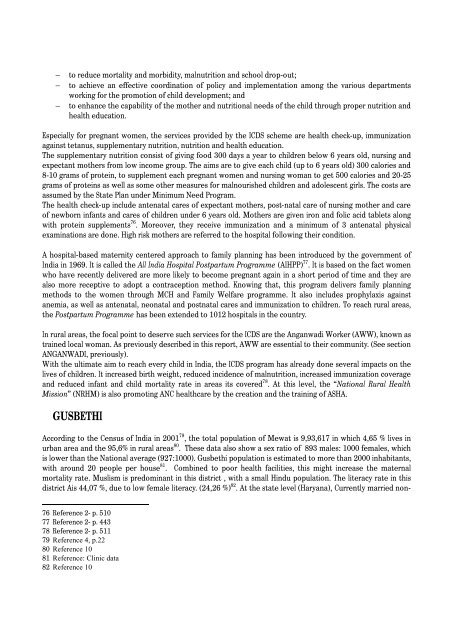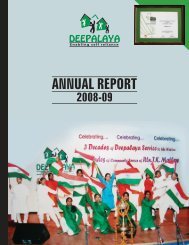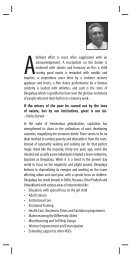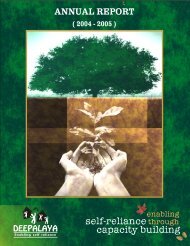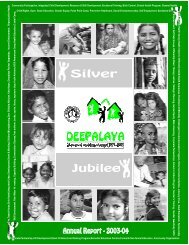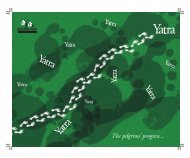Report 2011 - Deepalaya
Report 2011 - Deepalaya
Report 2011 - Deepalaya
Create successful ePaper yourself
Turn your PDF publications into a flip-book with our unique Google optimized e-Paper software.
− to reduce mortality and morbidity, malnutrition and school drop-out;<br />
− to achieve an effective coordination of policy and implementation among the various departments<br />
working for the promotion of child development; and<br />
− to enhance the capability of the mother and nutritional needs of the child through proper nutrition and<br />
health education.<br />
Especially for pregnant women, the services provided by the ICDS scheme are health check-up, immunization<br />
against tetanus, supplementary nutrition, nutrition and health education.<br />
The supplementary nutrition consist of giving food 300 days a year to children below 6 years old, nursing and<br />
expectant mothers from low income group. The aims are to give each child (up to 6 years old) 300 calories and<br />
8-10 grams of protein, to supplement each pregnant women and nursing woman to get 500 calories and 20-25<br />
grams of proteins as well as some other measures for malnourished children and adolescent girls. The costs are<br />
assumed by the State Plan under Minimum Need Program.<br />
The health check-up include antenatal cares of expectant mothers, post-natal care of nursing mother and care<br />
of newborn infants and cares of children under 6 years old. Mothers are given iron and folic acid tablets along<br />
with protein supplements 76 . Moreover, they receive immunization and a minimum of 3 antenatal physical<br />
examinations are done. High risk mothers are referred to the hospital following their condition.<br />
A hospital-based maternity centered approach to family planning has been introduced by the government of<br />
India in 1969. It is called the All India Hospital Postpartum Programme (AIHPP) 77 . It is based on the fact women<br />
who have recently delivered are more likely to become pregnant again in a short period of time and they are<br />
also more receptive to adopt a contraception method. Knowing that, this program delivers family planning<br />
methods to the women through MCH and Family Welfare programme. It also includes prophylaxis against<br />
anemia, as well as antenatal, neonatal and postnatal cares and immunization to children. To reach rural areas,<br />
the Postpartum Programme has been extended to 1012 hospitals in the country.<br />
In rural areas, the focal point to deserve such services for the ICDS are the Anganwadi Worker (AWW), known as<br />
trained local woman. As previously described in this report, AWW are essential to their community. (See section<br />
ANGANWADI, previously).<br />
With the ultimate aim to reach every child in India, the ICDS program has already done several impacts on the<br />
lives of children. It increased birth weight, reduced incidence of malnutrition, increased immunization coverage<br />
and reduced infant and child mortality rate in areas its covered 78 . At this level, the “National Rural Health<br />
Mission” (NRHM) is also promoting ANC healthcare by the creation and the training of ASHA.<br />
GUSBETHI<br />
According to the Census of India in 2001 79 , the total population of Mewat is 9,93,617 in which 4,65 % lives in<br />
urban area and the 95,6% in rural areas 80 . These data also show a sex ratio of 893 males: 1000 females, which<br />
is lower than the National average (927:1000). Gusbethi population is estimated to more than 2000 inhabitants,<br />
with around 20 people per house 81 . Combined to poor health facilities, this might increase the maternal<br />
mortality rate. Muslism is predominant in this district , with a small Hindu population. The literacy rate in this<br />
district Ais 44,07 %, due to low female literacy. (24,26 %) 82 . At the state level (Haryana), Currently married non-<br />
76 Reference 2- p. 510<br />
77 Reference 2- p. 443<br />
78 Reference 2- p. 511<br />
79 R e f e r e n c e 4 , p . 2 2<br />
80 R e f e r e n c e 1 0<br />
81 R e f e r e n c e : C l i n i c d a t a<br />
82 R e f e r e n c e 1 0


